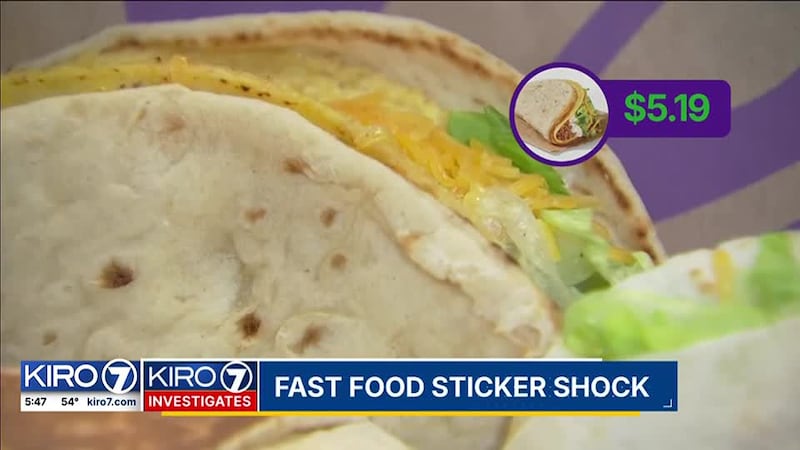Fast food has consistently outpaced inflation; but not only are prices higher, they are wildly inconsistent with huge swings in pricing from one location to the next… so what gives? We are hitting drive-thru’s up and down the sound to see what’s driving costs on your favorite fast food.
Americans and fast food go together like a hamburger and French fries.
It’s fast.
It’s easy.
And it is cheap!
But these days – only two of those things are true.
“For me and my coworker it was $42,” said David Larson when asked how much he spent on his lunch at Taco Bell.
David Larson and his coworker had stopped by a Taco Bell in Seattle’s lower Queen Anne looking for a quick bite, only to be bitten by high prices.
“They literally doubled the advertised price on the commercial,” Larson said.
Sure, they’re fed, but they’re also fed up with the high prices.
“I feel like I’m getting robbed and taken advantage of because [Taco Bell] are the only thing to eat on this side of Queen Anne,” said Larson.
Americans as a whole are hungry for value, but they’re not finding it.
In fact, fast food prices have outpaced inflation by 31% over the last decade according to recent Finance Buzz data.
We made a pit-stop at the University of Washington’s Foster School of Business so marketing professor, Jeff Shulman, could help us sift through this taco shell shock.
“Yeah, it’s eye-popping,” Shulman said.
“Part of it is the inflation is affecting the costs of fast-food restaurants,” said Shulman. “But part of it is also that inflation is giving these fast-food restaurants a cover for collectively raising their prices.”
Taco Bell in particular has raised menu prices by an average of 81% since 2014.
But it doesn’t stop there, each franchise gets to set its own prices, so you never really know what you’ll pay until your mid-drive thru.
“Whether it’s the Crunch Wrap Supreme or the Quarter Pounder, for the same exact item people are willing to pay more in certain contexts than in others,” said Shulman. “If they’re hungry, if they’re there and the food and the line is short, they’re going to pay a lot more than if they have to wait in line or travel further.”
The restaurant David and his coworker were at is widely known as one of the most expensive in the state of Washington, just ask Google reviews.
“They’re taking advantage of people based on a convenience fee,” Larson said.
So, we decided to see for ourselves, sending KIRO7 crews far and wide, to see just how big of a budget you need to have a bite at the bell.
Each crew ordered the same items: a cheesy Gordita crunch, a crunch wrap supreme, and a single soft taco.
The same food… very different receipts.
The cheapest? Found by our north sound crew in Everett ringing in at $15.90.
South Sound slides in next – with similar numbers at two places in Puyallup ($16.04 and $16.14).
On the east side? Slightly higher at $16.29.
Then… Seattle.
Of the three locations, we found good prices in Lake City at $15.95.
Add on a handful of change for the location in Ballard, for a total of $16.63.
Then, the big one, lower Queen Anne.
More than $22 dollars ($22.04 to be exact).
According to Taco Bell’s website a cheesy gordita crunch should cost $5.19. At the Taco Bell in Lower Queen Anne, we paid $8.
The Crunch Wrap Supreme is listed as $5.59 on the website. It was $8 for us.
And finally, the hardest blow dealt by a soft taco.
According to Taco Bell’s website, it should cost $1.79, our price? $3.89, nearly four dollars for a single taco.
Your mouth may be watering and now your eyes are, too.
We reached out to Taco Bell to try to make sense of all of this as we were crying over our crunch wraps.
They sent us back a statement saying:
“Our franchisees control their own restaurant prices. We don’t share details of our corporate restaurant pricing strategy for competitive reasons, but many factors come into play including local market costs.”- Taco Bell Corp.
And yes, there are a number of things that could be to blame like inflation, higher wages, and pricey rent.
But if you ask Professor Shulman – it’s likely not that deep.
“There are really very few opportunities to raise prices and get away with it. And this inflationary environment was an opportunity to get away with it. And they tried. And now they’re starting to realize that maybe they didn’t get away with it,” Shulman said.
“There’s still going to be some eye-popping menu items at these fast-food restaurants, but I think you’ll see more and more value items,” he added.
Until then fast-food franchises will keep frying up your favorites, with a side of sticker shock.
©2024 Cox Media Group








